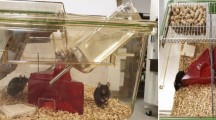Abstract
The behavior of individaals and their responses to external stimuli are controlled by the microsocial environment, which for most mammals is associated with dominant-subordinate relationships. Physiological and behavioral differences between dominant and subordinate individuals may be ‘primary’ (genetically determined) or ‘secondary’ (due to position in the group's hierarchical structure). A series of experiments was conducted to investigate the physiological (pain response threshold), immunological (thymus, spleen weights, primary immune response), and behavioral (motor activity, behavior in a shuttle box test) characteristics of dominant and subordinate individuals in groups of three laboratory mice formed on the basis of linear hierarchy. Assessment of the effects of group conditions was made using a conditioned reflex location preference test. The results showed: 1) there are no statistically significant differences in physiological and behavioral (except for motor activity) parameters between dominant and subordinate mice; 2) co-housing of dominant and subordinate individuals in groups with stable hierarchical relationships was not aversive for them.
Similar content being viewed by others
References
Ya. Buresh, O. Bureshova, and D. P. Houston,Methods and Basic Experiments in Studies of the Brain and Behavior [in Russian], Vysshkaya Shkola, Moscow (1991).
N. N. Kudryavtseva, “Features of the aggressive behavior of mice which win in inter-male interactions,”Zh. Vyssh. Nerv. Deyat.,36, No. 5, 1077–1082 (1986).
N. N. Kudryavtseva and I. V. Bakshtanovskaya, “Neurochemical control of aggression and submission,”Zh. Vyssh. Nerv. Deyat.,41, No. 5, 459–466 (1991).
A. V. Kulikov and N. K. Popova, “Studies of the genetic control of ‘spontaneous’ aggression in mice,”Genetika,26, No. 3, 527–531 (1980).
A. L. Markel', Yu. K. Galaktionov, and V. M. Efimov, “Factor analysis of rat behavior in the open field test,”Zh. Vyssh. Nerv. Devat.,38, No. 5, 855–863 (1988).
O. Manning,Animal Behavior [Russian translation], Mir, Moscow (1982).
N. A. Popova, S. I. Il'nitskaya, L. A. Kolesnikova, V. I. Kaledin, and N. N. Kudryavtseva, “The effects of chronic social conflicts on a number of non-specific resistance parameters in mice,”Ros. Fiziol. Zh. im. I. M. Sechenova,82, No. 12, 12–17 (1996).
V. P. Poshivalov, “Pharmacological analysis of hierarchical relationships in mice,”Zh. Vyssh. Nerv. Deyat.,29, No. 1, 167–173 (1979).
V. P. Poshivalov,The Experimental Psychopharmacology of Aggressive Behavior [in Russian], Nauka, Leningrad (1986).
V. P. Poshivalov and Yu. D. Ignatov, “The relationship between the behavioral response to pain and the hierarchical rank of an animal,”Zh. Vyssh. Nerv. Deyat.,34, No. 4, 767–770 (1984).
I. Roit,Essential Immunology [Russian translation], Mir, Moscow (1991)
L. I. Serova and E. V. Naumenko, “Zoosocial behavior and the endocrine functions of the gonads in male laboratory mice in micropopulations after selective degradation of noradrenergic neuron terminals in the brain,”Fiziol. Zh. SSSR,73, No. 1, 876 (1990).
L. I. Serova, A. V. Osadchuk, and E. V. Naumenko, “The genetic/neurochemical bases of population hierarchy in male laboratory mice. 1. The role of brain catecholamines,”Genetika,25, No. 1, 691–698 (1989).
S. A. Beden and P. F. Brain, “The primary immune responses to sheep red blood cells in mice of differing social rank for from individual housing,”ICRS Med. Sci.,13, 364–365 (1985).
D. Benton and P. F. Brain, “Behavioral comparisons of isolated, dominant and subordinate mice,”Behavioural Processes,4, 211–219 (1979).
D. Benton, J. C. Dalrymple-Alford, and P. F. Brain, “Comparisons of measures of dominance in the laboratory mouse,”Anim. Behav.,28, 1274–1279 (1980).
I. D. Chase, “Social process and hierarchy formation in small groups: a comparative perspective,”Amer. Sociol. Rev.,45, 905–924 (1980).
C. Drews, “The concept and definition of dominance in animal behaviour,”Behaviour,125, 283–313 (1993).
N. N. Kudryavtseva, “The sensory contact model for the study of aggressive and submissive behaviours in male mice,”Aggress. Behav.,17, No. 5, 285–291 (1991).
K. A. Miczek, “Tolerance to analgetic, but not discriminative stimulus effects of morphine after brief social defeat in rats,”Psychopharmacology,104, 181–186 (1991).
C. H. Wilde and W. H. Vogel, “Influence of the 5-HT1A agonist ipsapirone on voluntary alcohol intake in rats,”Alcohol,11, 411–415 (1994).
Author information
Authors and Affiliations
Rights and permissions
About this article
Cite this article
Vekovishcheva, O.Y., Sukhotina, I.A. & Zvartau, É.E. Co-housing in a stable hierarchical group is not aversive for dominant and subordinate individuals. Neurosci Behav Physiol 30, 195–200 (2000). https://doi.org/10.1007/BF02463158
Received:
Revised:
Issue Date:
DOI: https://doi.org/10.1007/BF02463158




